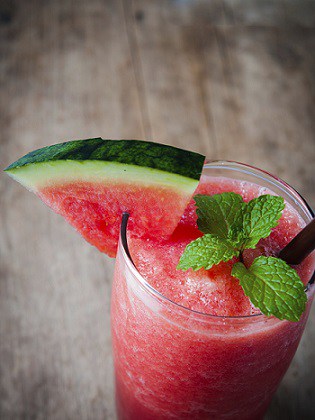 The general rule about fruits in the acne world is that they are a safe and recommended food to eat. They are usually high in antioxidants, contain plenty of acne nutrients, and many of their proven health effects can indirectly clear your acne.
The general rule about fruits in the acne world is that they are a safe and recommended food to eat. They are usually high in antioxidants, contain plenty of acne nutrients, and many of their proven health effects can indirectly clear your acne.
The truth is that diet is the real cause of acne, not bad hygiene. If you suspected that for years, you were correct all along…
…and eating nutritious fruits is one of the top dietary strategies you can follow. However the conundrum is that fruits are also quite high in sugar; 100 grams of the average fruit contains about 10 grams.
Therefore it is a good idea to organise your fruit consumption so that you both keep acne-causing sugar low, and eat the fruits which have the very greatest benefit for acne…
…and for this purpose the watermelon is a fantastic fruit to eat.
It is low in sugar, with just 6 grams per 100 grams, and most importantly, it has a particularly unique acne-improving effect. The majority of fruits, like berries, are useful for their antioxidants and skin-defending nutrients like vitamin C, but the watermelon has a powerful ability to aid your body’s wound healing process.
Therefore eating a watermelon can dramatically accelerate the healing of your old acne – leaving your skin with far less acne overall and causing huge improvements in the overall tone.
Watermelon heals old pimples
The main method through which it accomplishes this is the watermelon’s ability to increase nitric oxide in the body. Nitric oxide is actually a gas, and it is used by the body mainly for the purpose of vasodilation. That means that it relaxes your veins and arteries and allows the blood to flow a lot more freely.
For that reason doctors believe that nitric oxide is an excellent way to treat heart disease, high blood pressure and other circulatory diseases. It’s only recently that nitric oxide’s shocking ability to increase wound healing has been picked up:
ONE: scientists in this study reviewed several older studies and concluded that “Nitric Oxide plays a key role in wound repair”. At the end they encouraged further use of nitric oxide to treat the problem.
Read Annihilate Your Acne – get the ultimate diet and clear your acne permanently!
TWO: scientists in this review comment that there is excellent evidence for the role of nitric oxide in wound healing, although they still have no idea how it actually accomplishes this.
THREE: in this study from the Journal of Nanotechnology, scientists tried to establish the effects of nanoparticles that released nitric oxide. They found that sending them to the wounds of mice dramatically increased the speed at which they healed.
All in all the evidence for nitric oxide greatly accelerating wound healing is pretty strong, and is a growing area of scientific research. Update 20/8/2015 – it turns out that nitric oxide may have strong anti-inflammatory properties in acne patients as well as possibly killing p.acnes bacteria. Article on nitric oxide and acne here. Nobody knows how it accomplishes this yet, but the evidence we have means that NO is a very important substance for healing your acne…
…and the good news is that eating watermelon is one of the best ways to increase NO levels in the body. The watermelon is an extremely rich source of l-citrulline, a dietary amino acid. When l-citrulline enters the body, a good chunk of it is converted to l-arginine, which is also an amino acid.
The significance of this substance? L-arginine is the single most important bodily ingredient in the creation of nitric oxide. The body uses enzymes known as “nitric oxide synthases” to create nitric oxide, and they achieve this by directly converting l-arginine to NO.
Therefore, through a highly indirect yet tight process, watermelon can dramatically increase one of the substances that is most vital for the healing of your old acne. There aren’t many studies directly confirming watermelon’s ability to heal wounds (there is this one) but each individual step in the process is so backed up by science that it is as good as confirmed in my reckoning.
L-citrulline is a particularly revered substance these days. Its nitric-oxide boosting (and therefore acne curing) effects are so established, that the supplement industry has quickly leapt on board. There’s already a supplement called “citrulline malate” available, that some proclaim to be the next big thing in athletics, and more is on the way.
Recommended – the top 6 vitamins and minerals for acne-free skin
The significance for you is that the same benefits that the companies are fixated with are also the ones that are great at healing your old acne. (What people don’t realise though, is that these astonishing benefits are already available in your local fruit market.)
The best news is that the acne healing powers of watermelon don’t stop there. Both its flesh and its rind are an excellent source of vitamin C, which is just as vital for wound healing as nitric oxide is. Overall if you are having any trouble with getting your old acne to heal up, then watermelon is one of the best fruits you could possibly eat…
Watermelons lower inflammation thanks to lycopene
…and on top of that, the watermelon can reduce acne-causing inflammation excellently. There’s an antioxidant that’s found in tomatoes called lycopene which gives them their red colour. Scientists have been studying this compound relentlessly and they have found that it benefits the human body in all sorts of ways, from reducing the risk of stroke and heart attacks to being highly anti-inflammatory.
This led to scientists all bowing down before the tomato and recommending it as one of your key five a day fruits…
…but recently scientists have discovered that the watermelon is actually a much better source of lycopene than the tomato is. 100 grams of watermelon contains roughly 1.5 times more lycopene than the same weight of tomatoes. That means that the watermelon is an anti-inflammatory powerhouse, a fact that is backed up by these studies:
The top 7 topical treatments for clearing acne naturally
ONE: in this study a team of scientists found that “Lycopene on its own effectively reduced inflammation by inhibiting the release of TNF-α and stimulating IL-10 production”. That basically means that not only did lycopene stimulate anti-inflammatory immune system chemicals in the body, but it also inhibited the pro-inflammatory chemicals behind acne.
TWO: this study was actually done on watermelon lycopene in particular, and the scientists found that lycopene inhibited an inflammatory chemical known as cyclooxygenase-2 (COX-2). The scientists concluded that “the watermelon lycopene was proved as a good source of antioxidant and anti-inflammatory agents”. COX-2 controls the release of many pro-acne inflammatory chemicals. Interestingly, they also claimed that watermelon lycopene is more powerful than the famous tomato version.
So the basic conclusion from all this is that the watermelon is a highly anti-inflammatory food. That’s great news for your acne because chronic inflammation is the single biggest reason why pimples form in the first place. You can have all the blocked pores you want, but without inflammation your face will be as clear as a baby’s.
Eating watermelon every day is an excellent way to prevent acne even getting a foot in the door, and the best part is that watermelon contains several more anti-inflammatory enzymes as well…
One of those enzymes is cucurbitacin-e, which is a potent inhibitor the COX-2 enzyme. That’s the same inflammatory chemical referenced in the study above which controls chemicals behind acne and it’s also the same one that aspirin inhibits.
Why bread and pasta are a massive cause of acne
Indeed the watermelon seems to have an aspirin-like effect on the body overall. From all the evidence already mentioned I firmly recommend the watermelon as an anti-inflammatory food. There haven’t been any direct studies on whether watermelon itself is anti-inflammatory, but because we know that so many of the substances found in it are, we can easily connect the dots.
Basically, watermelon is like nature’s version of aspirin. Most fruits have some anti-inflammatory properties but the watermelon seems to be one of the better ones. Therefore I would at least put it in the upper 50% of inflammation-curing fruits, possibly even the top 25%.
The benefits don’t end there
 On top of the anti-inflammatory and wound healing powers, the watermelon is also a decent source of some other important acne nutrients. It contains 13% of the RDA for vitamin C, which can reduce stress hormones behind acne like cortisol, and also 11% of the RDA for vitamin A, the second greatest vitamin for acne.
On top of the anti-inflammatory and wound healing powers, the watermelon is also a decent source of some other important acne nutrients. It contains 13% of the RDA for vitamin C, which can reduce stress hormones behind acne like cortisol, and also 11% of the RDA for vitamin A, the second greatest vitamin for acne.
Those nutrients are actually just as concentrated in the green rind of the watermelon as its red flesh. Being both a vegetable and a fruit (by official classification), the entirety of the watermelon fruit is edible, including both the seeds and the rind. Those vitamins are the acne nutrients for which watermelon is the best source, but then there are numerous trace minerals, b-vitamins, and most likely other, undiscovered compounds.
Why dairy can either destroy your skin or improve it
Basically, you should not pay any attention to the people who mock the watermelon and claim that it is nothing but water and sugar. This fruit is a serious contender for acne patients and the studies above speak for themselves. Watermelon is certainly a better fruit for acne than apples, pears, green grapes and regular melons, and I’d say they’re just as good for acne as fruits like cherries, oranges, papaya, and even some berries.
Watermelons are a fruit so they’re free from dodgy additives; there are no fillers, preservatives, no added sugar, and no inflammatory gluten, and no vegetable oils like canola oil, which are some of the worst ingredients ever for acne.
As I said above, I particularly recommend watermelon if you want to accelerate the healing of old acne. Perhaps your acne went through a particularly bad phase over the winter and now that the summer is approaching, you want to heal all the remaining acne in order to get the general tone of your skin looking excellent.
In that instance, a few months of eating watermelon every day would be a great idea. It’s a good fruit to eat in just about any instance with acne, or indeed if you don’t have acne.
Watermelon also has other healthy effects on the body such as…
-Improved circulation (due to the nitric oxide).
-Reduced risk of heart disease (due to the improved circulation).
-Improved wound healing in the rest of your body, so that means greater fitness in general.
-Research shows that the same l-citrulline which leads to improved healing of acne can also cause a nice drop in blood pressure (again due to nitric oxide).
-Reduced muscle pain, due to the anti-inflammatory powers.
Aside from being great for acne patients, the watermelon is also a good food for athletes and other physically active people. Some of its health properties are of particular use to those who exercise regularly, such as wound healing, heart health, and reduced pain in muscles.
Watermelons are low in sugar
The next question is, as with all fruits, the question of how much acne-causing sugar the watermelon contains. The answer is that the watermelon is one of the least sugary fruits in the business. The fruit contains just 6 grams of sugar per hundred grams of weight. That’s only one gram more than the same weight of strawberries or raspberries, which are always enjoying praise for their low levels of sugar.
That basically means that compared to fruits such as grapes (which are slightly too sugary), you can enjoy the acne busting benefits of watermelons a lot more. My basic recommendation to acne patients regarding the sugar in fruit is not to exceed three servings a day, unless they are very low sugar fruits. So, for example, you could have three servings of berries and one serving of watermelon in a day (all low in sugar), or you could have one serving of watermelon, one barely ripe banana (moderate sugar), and one serving of pomegranate (high in sugar).
By following such a strategy you can fit in plenty of watermelon, while both enjoying its benefits and preventing acne via sugar overdose.
Vitamin E – the ultimate nutrient for clogged pores
Theoretically, watermelons do have one problem when it comes to sugar. The ratio of the sugar between fructose and glucose is heavily tilted towards fructose. 100 grams contains approximately 1.9 grams of glucose but 3.9 grams of fructose.
In my eBook Annihilate Your Acne there’s a section on how fructose is actually far worse for causing acne than glucose is. It’s better to have a natural sugar ratio tilted towards glucose.
But watermelon is still safe, because the overall level of sugar is so low that the poor ratio won’t cause harm. Consider a kiwi fruit; it has a better fructose ratio than watermelon, of exactly 1:1, but because the sugar total is higher, it still contains more fructose at 5 grams.
Do watermelons have any downsides at all? The only major flaw that could actually give you acne in the real world rather than just theoretically is their high levels of FODMAPs. Watermelon is one of the highest fruits in FODMAPs around, alongside apples, peaches, apricots and blackberries. If word hasn’t reached you yet, then FODMAPs are short chain carbohydrates which some people have trouble digesting, which leads to acne on their face.
Watermelons are particularly known for their polyols (the P of the acronym), natural sugar alcohols which cause ingestion and stomach pain. For that reason, it’s a food that doctors warn against when prescribing a low-FODMAP diet.
If you are FODMAP sensitive then you’ll want to avoid watermelon. But otherwise you’re good to go.
Keep your eyes open!
Finally, if you do decide to eat watermelon for curing acne or otherwise, then keep your eyes peeled for these…
That isn’t a Christmas present with some cool watermelon patterned wrapper; it is actually a cube shaped watermelon. These things are all the rage in Japan and the whole of East Asia at the moment. Apparently the Japanese population was getting sick of regular watermelons, because whenever they tried to cut them open, they just rolled away…
…so in 2001 a Japanese farmer came up with the genius idea of planting a watermelon, and then sticking a box on the top of it. The watermelon actually grew into the box, and ended up as a square shape.
Now the Japanese can’t get enough of them. With some luck they might grace our supermarkets too at some point. I’ve never seen them but surely it’s just a matter of time before they reach our shores.
Conclusion
The general consensus in the health community is that watermelon is “nothing more than a bag of sugar and water”…
…and there is some truth to what they’re saying; the watermelon is actually 92% water and 6% sugar.
However those kind of comments don’t give this fruit the credit it deserves, because the remaining two percent is made up of some very powerful acne curing chemicals. Eating a serving of watermelon every day is particularly good for accelerating the healing of your old acne, and for reducing acne-causing inflammation in the body.
As we discussed earlier, watermelon is almost like nature’s aspirin. So next time you read reports in the paper that 95% of the world’s population should be on aspirin, perhaps you’d be better off eating a watermelon instead…
NEXT: get the complete strategy for clearing acne naturally
Thanks for reading!
